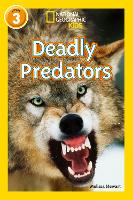|
|
lions, tigers, leopards, etc.
|
|



|
|
| book details |
Deadly Predators: Level 3 (National Geographic Readers)
By (author) Melissa Stewart, By (author) National Geographic Kids

|
| on special |
normal price: R 341.95
Price: R 324.95
|
| book description |
National Geographic Primary Readers pair magnificent National Geographic photographs with engaging text by skilled authors to help your child learn to read. Developed by education experts, this series of books for beginner readers is spread across four levels: Early Reader, Becoming Fluent, Becoming Independent and Independent Reader. Come face-to-face with sharks, wolves, tigers, and many more predators in this gripping Nat Geo Kids Level 3 Reader. Spectacular National Geographic photographs will amaze kids as they discover how predators hunt, raise their young and contribute to the food chain. Written in easy-to-comprehend text, this book for young readers will help children understand who rules in the wild! Level 3: Becoming Independent books are best suited for kids who are ready for complex sentences and more challenging vocabulary, but still draw on occasional support from adults. They are ideal for readers of Purple and Gold book bands for guided reading. For another National Geographic Level 3 Reader, try Weird Sea Creatures (9780008266721).
| product details |

Normally shipped |
Publisher | HarperCollins Publishers
Published date | 2 Oct 2017
Language |
Format | Paperback / softback
Pages | 32
Dimensions | 229 x 152 x 2mm (L x W x H)
Weight | 50g
ISBN | 978-0-0082-6671-4
Readership Age |
BISAC | juvenile nonfiction / animals / lions, tigers, leopards, etc.
| other options |
|
|
|
To view the items in your trolley please sign in.
| sign in |
|
|
|
| specials |
|
|
|
Look around you is anything real or normal any more? News, images and videos created by AI are everywhere.
|
This first comprehensive biography of Cecil Rhodes in a generation illuminates Rhodes’s vision for the expansion of imperialism in southern Africa, connecting politics and industry to internal development, and examines how this fueled a lasting, white-dominated colonial society.
|
|
|
|